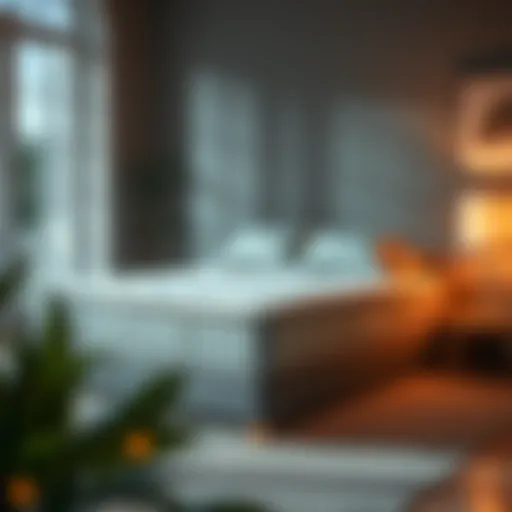Exploring Decorative Wall Hangers for Plant Aesthetics
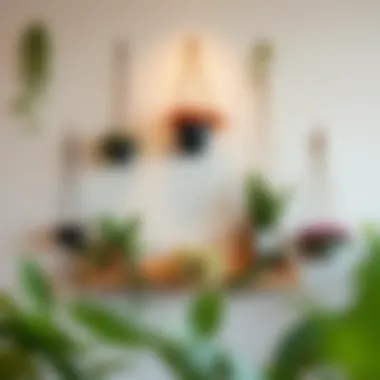

Intro
In a world where indoor plants have blossomed into undeniable staples of contemporary decor, finding ways to display our vibrant green friends becomes a task of artistry. Decorative wall hangers for plants not just serve a practical purpose, but also add a splash of elegance that can transform bland walls into breathtaking showcases. This exploration will dig deep into the artistry, materials, and innovative trends surrounding these fixtures, aiming to arm homeowners, designers, and plant enthusiasts alike with knowledge that teeters on the brink of the artistic and the functional.
The right wall hanger can elevate not just the aesthetics of your living area but also enhance the overall health of your plants, providing them the light and airflow they truly need. You might find yourself wondering: What materials are best suited for creating these wall adornments? or How can I ensure my plants thrive in such setups? Prepare for a journey that will answer all these burning questions and more, leading to the creation of rustic, trendy, or eclectic spaces that resonate with individual style and eco-conscious practices.
Furniture Styles and Trends
Understanding the aesthetic appeal of decorative wall hangers for plants requires a glance at the varying styles they embody. By categorizing options, one can seamlessly merge these hangers with their existing decor.
Modern vs. Traditional: Understanding the Aesthetics
Modern styles often eschew heavy materials in favor of sleek designs made with metal or wood, allowing for a minimalist approach. Think of smooth lines and geometric shapes. On the other hand, traditional styles hark back to naturalistic influences, often utilizing wrought iron and classic designs which add warmth to homes.
Here are some standout points to keep in mind:
- Modern Hangers: Favor natural hues or metallic finishes. They represent the "less is more" philosophy.
- Traditional Hangers: Tend to have intricate designs and rich, deep wood tones that exude a sense of nostalgia.
Color and Material Trends: What's In and What's Out
Color trends now resonate with a desire for earthy tones and muted palettes. Opting for greens, browns, and creams creates a harmonious background dealing with plant displays. Meanwhile, statement colors can bring life to the space- think coral or royal blue.
Material-wise, some trends you might notice:
- Bamboo: Gaining traction for being sustainable and lightweight.
- Recycled Metals: Drawing attention as eco-conscious materials that boast durability.
- Macramé: Making a massive comeback; the visual appeal stems from hand-knotted designs.
"A well-placed wall hanger can become a talking point for guests, blending functionality with artistry."
Transforming walls with plants isn't just about hanging a few pots; it's about crafting an experience that reflects who you are. We will now begin to delve deeper into how to care for these wall-mounted beauties and maintain their allure.
Furniture Care and Maintenance
Keeping those wall hangers in good shape plays a huge role in ensuring your plants thrive. The last thing you want is for your décor to suffer due to negligence.
Tips for Prolonging the Life of Your Hanger
- Material Matters: Ensure your wall hangers are made with weather-resistant materials if placed outdoors.
- Occasional Cleaning: Dust and grime can dull the look; a gentle wipe-down with a damp cloth works wonders.
- Secure Mounting: Check that anchors and screws are holding firm—avoid any mishaps and potential plant casualties.
DIY Repair Hacks for Common Issues
In the instance that a hanger gets damaged, there’s no need to sweat! Here are some fixes:
- Tightening Screws: Often, a simple adjustment can stabilize a loose hanger.
- Rust Removal: For metal, using vinegar can effectively lift corrosion; just remember to follow up with a protective coat.
By fully understanding how to select, care for, and maintain decorative wall hangers, homeowners and enthusiasts will be well-equipped to maximize not only their plant displays but also the aesthetic value of their spaces. Such detailed knowledge empowers one to choose the right solutions that complement a lifestyle steeped in design and nature.
Preamble to Decorative Wall Hangers for Plants
Decorative wall hangers for plants blend functionality with aesthetics, creating a unique way to incorporate nature into indoor environments. Their importance extends beyond mere decoration; they enable homeowners and designers alike to leverage vertical space effectively, introducing greenery where traditional plants might not fit. With urban living spaces becoming smaller, utilizing walls as potential gardens emphasizes both practicality and creativity. This article explores various aspects of decorative wall hangers, delving into design, materials, styles, and the profound impact they have on our living spaces.
Defining Decorative Wall Hangers
Decorative wall hangers encompass a diverse range of design concepts, materials, and functionalities that allow plants to flourish in non-traditional ways. At their core, these hangers are designed to support the growth of plants, transforming vertical surfaces into lush gardens. This definition includes everything from simple hooks to elaborate shelving designed specifically for potted plants, crafting an engaged relationship between aesthetic appeal and plant health.
In the market, wall hangers come in various designs—wooden shelves can lend a rustic touch, while metal structures might add a more industrial feel. They are often adjustable and can be tailored to fit the individual preferences of homeowners and designers.
The Impact of Plants on Interior Spaces
Incorporating plants into interior spaces offers numerous benefits, enhancing not just look but also air quality and emotional wellbeing. Studies indicate that indoor plants can significantly purify the air, absorbing toxins and releasing oxygen, which contributes to a more healthful environment. Furthermore, they bring a sense of calm and renewal, known to reduce stress and boost productivity.
Plants enhance color palettes in rooms, harmonizing with surrounding decor in a way that brings depth and vitality. For instance, a few cascading vines can soften the sharp edges of modern furniture, offering a balance that is visually appealing. Additionally, wall hangers can serve as focal points, drawing the eye to specific areas of a room, which in turn can create more engaging and dynamic living spaces.
"Plants in any form serve as a bridge between nature and our daily lives."
Overall, decorative wall hangers not only serve to display plants but also elevate the spaces we inhabit, enhancing both aesthetic quality and our overall living experience.
Design Considerations for Wall Hangers
When thinking about decorative wall hangers for plants, it's not just about including more greenery in our lives. The design aspects can make or break the aesthetic and functional qualities of your space. Homeowners, designers, and DIY enthusiasts should keep several factors in mind to ensure that the wall hangers effectively elevate their interiors.
Aesthetic Appeal
The visual element of wall hangers plays a substantial role in how they are perceived. A well-designed hanger not only complements the plants but also ties in with the overall theme of the room. For instance, a minimalist metal hanger can enhance a contemporary decor, while a rustic wooden hanger may resonate better in a farmhouse-style space.
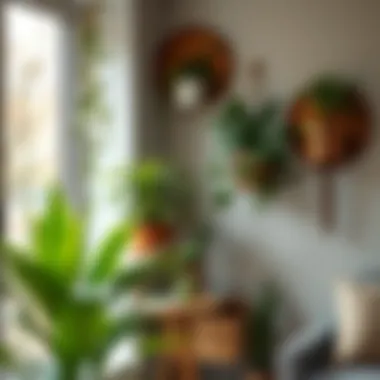

The art of balancing color, shape, and texture is pivotal. A bright ceramic pot might pop against a stark white wall, but it could get lost in a busy patterned wallpaper. Here are a few points worth considering:
- Color Coordination: Choose colors that match or contrast well with your wall and furniture.
- Shapes and Forms: Select designs that create visual interest; round pots on angular hangers, for example, can offer an exciting juxtaposition.
- Textures: Mixing materials, such as wood and metal, can add rich layers to the visual composition of your wall.
"A plant's personality shines through its container. The right hanger can amplify that character beautifully."
Functionality and Practicality
Looks aside, the functionality of decorative wall hangers cannot be overlooked. It's imperative not just to have a piece that looks good, but also one that serves its purpose well. This includes ensuring that the wall hangers can support the weight of the plants without a hitch, which is especially important for larger or heavier specimens.
Additionally, consider the following:
- Ease of Access: A hanger that's easy to reach will make watering and care more manageable.
- Stability: Before purchasing, confirm that the design provides a stable platform for your plants. You wouldn’t want your favorite fern coming crashing down.
- Versatility: Look for hangers that can be adapted if you decide to switch out plants or even decor styles later down the road.
Size and Space Utilization
Understanding the dimensions of your available space is crucial. Wall hangers should fit comfortably within your chosen area without overwhelming it. Whether it’s a narrow corner or a spacious wall, the scale of the hangers must correspond with the environment.
When thinking about size:
- Consider Plant Growth: Remember that plants grow. Start with a hanger that can accommodate the mature size of your chosen flora.
- Spacing: Hangers shouldn't be too close together, as plants need light and airflow to thrive. Think about how they interact with each other and the surrounding area.
- Horizontal vs. Vertical: Depending on the layout of the room, choose between hangers that expand horizontally for wide spaces or vertical hangers for tighter walls, maximizing your vertical space.
In sum, the design considerations for wall hangers involve more than aesthetics. A beautiful hanger must also be functional and appropriately sized to create a harmonious and productive living area.
Materials Used in Wall Hangers
When it comes to decorative wall hangers for plants, materials play a pivotal role. The choice of materials can significantly affect the visual appeal, durability, and functionality of the hangers. Each material carries its own charm and practicality, catering to different tastes and purposes. By understanding the various options available, homeowners, designers, and DIY enthusiasts can make informed decisions that align with their interior visions. Below, we delve into some common materials used in crafting these plant hangers, considering their unique characteristics and benefits.
Wood: A Classic Choice
Wood has long been revered in interior design for its warmth and versatility. When thinking of wall hangers, a wooden aesthetic provides an organic feel that easily complements various décor styles.
- Natural Beauty: Wood offers a timeless appeal. Whether polished or left in its raw state, the unique grain patterns make each piece one-of-a-kind.
- Durability: Solid wood can withstand considerable weight, making it suitable for a wide range of plant sizes and types. Pine, oak, and cedar are popular choices due to their strength and resistance to decay.
- Customization: Wood can be easily stained, painted, or treated to fit personal aesthetics. A wood stain, for instance, can transform a simple piece into a rustic masterpiece.
The use of wood also resonates well with the sustainability movement. Homeowners looking to minimize their environmental footprint often prefer wooden hangers sourced from sustainable forests.
Metal: Modern and Sleek
Metal wall hangers introduce a sleek, contemporary edge to plant décor. This material shines in both urban and minimalist designs, appealing to those who favor a modern aesthetic.
- Variety: Available in different finishes like matte, polished, and even wrought iron, metal can conform to various styles, from industrial to chic.
- Strength: Metal is incredibly strong, making it capable of holding heavier planters and larger plants, thus expanding the range of plant types one can display.
- Easy Maintenance: A quick wipe with a damp cloth is all it takes to keep metal hangers looking their best. Unlike wood, metal does not rot or warp when exposed to moisture, which is a bonus for plant health.
With its enduring nature and clean lines, metal provides a contrast that pairs beautifully with lush greenery.
Ceramic: For a Touch of Elegance
Ceramic wall hangers add an element of sophistication that many find irresistible. Often glazed and intricately designed, they can be as decorative as the plants they hold.
- Artistic Flair: Hand-painted or uniquely shaped ceramic hangers serve as art pieces in their own right, allowing for a vibrant touch in any setting.
- Water Resistance: Glazed ceramics are particularly effective at resisting moisture, ensuring the plants thrive without damaging the hanger itself.
- Diversity: From modern geometric designs to traditional patterns, there are countless options in ceramic materials, catering to diverse tastes.
Ceramic hangers appeal to individuals who appreciate beauty and craftsmanship, making them an attractive option for more traditional or eclectic décor.
Recycled and Sustainable Materials
In an age of increasing awareness about environmental conservation, wall hangers crafted from recycled and sustainable materials have become quite the trend.
- Eco-friendly Choices: Materials sourced from recycled plastics or reclaimed wood provide a sustainable alternative while reducing waste. This type of hanger not only serves its purpose but also tells a story—one of conservation and creativity.
- Unique Aesthetics: Hangers made from recycled materials can embody quirky designs, presenting an interesting contrast to more polished options. The imperfections often tell tales of their previous life.
- Support for Green Companies: Buying from companies that focus on sustainability helps promote responsible practices and fosters an eco-conscious community.
Incorporating hangers made from recycled materials allows enthusiasts to make environmentally friendly choices without compromising on style.
By understanding the various materials used in wall hangers, one can curate an assortment that not only enhances the aesthetic value of interiors but also reflects personal values and preferences.
Styles of Decorative Wall Hangers
When it comes to decorative wall hangers for plants, the style you choose can speak volumes about your personality and aesthetic preference. The right style enhances not only the beauty of your plants but also creates a harmonious visual flow within your interior spaces. Different styles cater to various tastes, preferences, and home environments, providing options that can fit into contemporary, traditional, or eclectic designs. Taking the time to select a style that resonates with you can ultimately provide both aesthetic pleasure and functional benefits.
Minimalist Designs
Minimalist designs focus on simplicity and understated elegance. These wall hangers prioritize function while reducing visual clutter. They often feature clean lines, neutral colors, and materials that emphasize the beauty of the plants themselves rather than the hanger. For instance, a sleek, wall-mounted planter made from a single piece of wood can effortlessly showcase a small fern or succulent, allowing the green to pop against a muted backdrop.
Emphasizing negative space is vital in minimalist designs. By using wall hangers that leave ample space around the plant, you create a sense of openness and tranquility in a room. A key benefit of this style is its versatility; minimalist hangers can be adapted to any room, complementing modern decor or even different styles by acting as a soothing contrast.
Bohemian Vibes
If you want your space to emanate creativity and warmth, bohemian-style wall hangers might be your best bet. These designs are often eclectic, featuring vibrant colors, varied textures, and patterns that reflect a relaxed and free-spirited lifestyle. Think about a colorful macramé plant hanger suspended from a bamboo rod – the strands create an eye-catching display while emphasizing the organic forms of the plant.
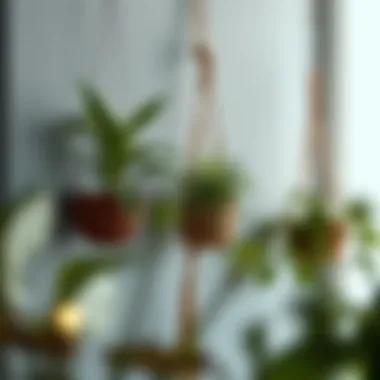

Bohemian vibes invite an informal ambiance, making them a fit for casual living spaces. You can mix-and-match hangers with different shapes and colors on one wall to create a gallery-like effect. Benefits of selecting this style include fostering a fun, expressive atmosphere while also allowing for personal stories through the choice of plants and hangers.
Industrial Aesthetics
Industrial aesthetics lean heavily on raw materials and bold designs. Characterized by their use of metal, concrete, and reclaimed wood, these wall hangers deliver a robust, edgy look that suits urban settings well. You might find a copper conduit used as a vertical support for hanging planters, presenting a striking contrast against greenery.
The beauty of industrial designs lies in their pragmatic appeal; they can accommodate heavier plants or larger pieces due to their sturdy construction. Additionally, this style resonates well in lofts or minimalist homes, reflecting a modern industrial vibe that emphasizes functional beauty.
Nature-Inspired Themes
Nature-inspired themes in decorative wall hangers create a seamless blend between the interior environment and the natural world outside. These styles often incorporate elements such as organic shapes, earthy colors, or even materials that mimic natural forms. Think of a wall hanger crafted to resemble a branch or leaves that cradle the plant.
By integrating nature-inspired wall hangers into your decor, you foster a therapeutic atmosphere that promotes relaxation and connection with the environment. Such designs often encourage the inclusion of native plants or herbs, adding not only beauty but also a sense of well-being as they enhance air quality and bring the essence of the outdoors inside.
The choice of style can dramatically influence how plants interact with your living space. By understanding and appreciating these various styles, you can create a visual identity that resonates with your personal aesthetic while highlighting the beauty and importance of greenery in your home.
Installing Wall Hangers: Practical Steps
When it comes to incorporating decorative wall hangers for plants into your space, the installation process serves as a foundation for both aesthetics and plant health. Without proper installation, the unique designs and practical benefits of wall hangers can quickly unravel. Understanding the nuances of this task not only ensures that your plants are displayed beautifully but also that they thrive in their new environment. In this section, we will walk you through the essential steps to achieving a successful and efficient installation.
Choosing the Right Location
Selecting the perfect spot for your wall hangers is vital in maximizing their visual impact and ensuring your plants receive adequate care. Here are several factors to consider:
- Lighting Conditions: Each plant requires a different level of sunlight. It’s essential to assess natural light in your chosen area. If your plant is a sun-seeker like a succulents, an east-facing wall might be optimal. Alternatively, shade-loving ferns will thrive in more secluded nooks.
- Accessibility: You'll want to make sure that you can easily access your plants for regular maintenance. Hanging them too high might complicate tasks like watering or pruning, leading to potential neglect.
- Room Aesthetics: Consider how your wall hangers will fit into the overall design of the room. A visually appealing arrangement can create a focal point or subtly enhance your decor. Think about balancing colors and materials with existing furniture.
Tools and Materials Needed
Having the correct tools and materials on hand streamlines the installation process and minimizes headaches. Here’s a handy checklist:
- Drill: A power drill is necessary for creating holes in the wall, especially if you are working with sturdier materials.
- Screws and Anchors: Choose screws that fit your wall type, whether it’s drywall, brick, or concrete. Anchors are crucial for heavy hangers or larger plants.
- Level: This tool is indispensable to ensure durability and alignment of your wall hangers.
- Measuring Tape: To maintain symmetry and spacing between multiple hangers, accurate measurements are critical.
Before starting, ensure all materials are compatible with the wall surface for long-lasting support.
Step-by-Step Installation Process
Installing wall hangers is straightforward, provided each step is followed diligently. Here’s how you can do it:
- Mark Your Spot: Using your measuring tape and level, mark the desired location for your wall hangers with a pencil. Make sure they are evenly spaced and aligned.
- Drill Holes: Using the power drill, create holes at the marked spots, being cautious to select the appropriate drill bit based on the wall material.
- Insert Anchors: For heavier hangers, insert wall anchors into the drilled holes. These will provide added support for your wall hangers.
- Attach Hangers: Align your decorative wall hangers with the holes and, using screws, attach them firmly to the wall, ensuring they are level.
- Test Stability: Give the hangers a slight tug to ensure they are securely fixed before adding any plants.
- Hang Your Plants: Finally, introduce the plants to their new home on the hangers and take a step back to appreciate your handiwork.
Proper installation is not just a task; it’s a way to respect your plants and your living space.
With careful selection of location, adequate preparation of tools, and a methodical installation approach, decorative wall hangers can transform your plant display into a stunning visual narrative within your home.
Caring for Plants in Wall Hangers
Caring for plants in wall hangers is a critical aspect that directly influences the sustainability and beauty of your green decor. It goes beyond aesthetics; the health of your plants contributes to the overall ambiance of your home. When plants are positioned in various wall mounts, they not only enhance your living space but also serve as a living testament to the bond between nature and interior design. However, more than just striking visuals, proper plant care ensures that these living decorations flourish, providing the many benefits associated with greenery in our homes.
Watering and Drainage Solutions
When it comes to watering plants in wall hangers, it is vital to adopt a system that balances moisture without leading to root rot. One common practice is to install drip trays or catchment dishes beneath each hanger to prevent water from damaging walls. Choosing the right potting mix also plays a role; opt for lightweight soil with good drainage properties. Some hangers are equipped with self-watering systems, allowing you to maintain consistent moisture levels.
*Consider the following:
- Frequency of watering: Generally, tropical plants need more frequent watering compared to succulents.
- Check for drainage holes: Ensure pots have sufficient drainage holes to allow excess water to escape.
- Use moisture meters: This handy tool can help gauge when your plants need water without overdoing it.*
Light Requirements
Understanding the light needs of each plant is pivotal for their survival. Plants in wall hangers may be positioned in various light conditions, which can be different from those on traditional shelves. For instance, succulents require bright, indirect sunlight, while ferns thrive in more shaded areas. Observing your plants regularly can give clues about their light requirements. If a plant shows signs of stretching or its leaves become pale, it is likely not getting enough light.
*Here are some pointers to consider:
- Identify light levels: Different areas of your home may have high, medium, or low light. Knowing where your wall hangers will be placed can influence plant choice.
- Rotate your plants occasionally: This ensures even exposure to sunlight.
- Consider supplemental lighting: If natural light is scarce, you might want to invest in grow lights, especially in darker months.*
Fertilization Tips
Proper fertilization is the secret sauce to vibrant, thriving plants in wall hangers. The nutrients in potting soil deplete over time, so feeding your plants becomes necessary as they grow. Organic fertilizers often provide a gentle option for plant nutrition, releasing nutrients slowly without the risk of burning roots.
Moreover, be mindful of the fertilization schedule. Over-fertilizing can lead to a host of problems like brown leaf tips or stunted growth.
*Take note:
- Type of fertilizer: Liquid fertilizers can be easier to assimilate, while granule forms release nutrients gradually.
- Time of year: Generally, spring and summer are optimal for feeding. During fall and winter, plants slow their growth and require less feeding.
- Observe plant response: If growth appears lush or foliage is changing color, adjust the fertilization routine accordingly.*
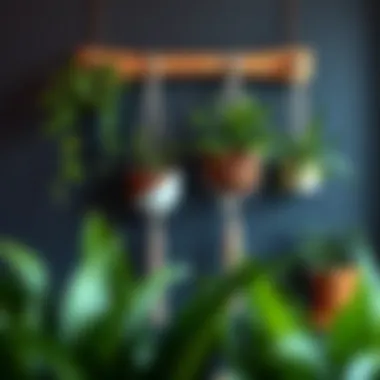

All these aspects are critical and require a bit of effort but will pay off with lush, beautiful plants that enrich your living space. With the right care tailored specifically for wall hangers, your green companions can thrive, adding life and vibrancy to your home design.
Customization Options for Wall Hangers
Customization options for wall hangers play a vital role when it comes to creating unique and personalized decorative pieces for your home. Rather than settling for something off the shelf, tailoring wall hangers to reflect personal style not only enhances the aesthetic appeal of your living space, but also signals your attention to detail and creativity. From choosing shapes and sizes to materials, the customization process allows homeowners, designers, and DIYers to truly make these hangers their own.
Personalizing Designs
When it comes to personalizing designs, the sky's the limit. Do you prefer geometric patterns or something more organic? Maybe you see your space filled with hues of pastels, or perhaps a more vibrant palette suits your taste. Whatever direction you choose, the design of your wall hangers can directly influence the overall mood of a room. Here are a few ways to customize:
- Shape Selection: Opt for rounded hangers for a softer look or go for angular forms to present a bolder statement.
- Custom Sizes: Depending on the space available, you might want larger hangers that make a dramatic effect or smaller pieces that can fit into tighter spots.
- Personal Symbols: Incorporate symbols or logos that resonate with you. These could reflect family heritage, hobbies, or aspirations.
"Design is an opportunity to continue telling the story, not just to sum everything up." – Tate Linden
Customization not only offers visual appeal but can also have functional benefits. For example, a specially designed wall hanger may better accommodate specific planters, ensuring plants thrive while also being artistically presented. Tailoring designs helps avoid that cookie-cutter look that some mass-produced items tend to have, adding depth and personality to your decor.
Incorporating Unique Textures and Colors
When it comes to bringing your wall hangers to life, textures and colors often steal the show. Combining different textures can intrigue the eye and create a multi-dimensional display. Consider these options:
- Mixed Materials: Use wood alongside ceramic for a warm yet sophisticated touch. Metal accents can add even more visual interest.
- Rich Color Schemes: Think beyond neutrals; teal or mustard yellow might make a statement in a modern space. Custom painting or using unique finishes can help achieve that personalized look.
- Natural Elements: A rustic vibe can emerge using rough finishes or adding elements like natural fibers.
Colors and textures often spark emotions and set the tone. You might want your hangers to instill calmness or energize a space; even the color white can convey simplicity and purity, while tones of red can symbolize excitement and activity.
Mixing and matching these elements not only showcases your creativity but also elevates the overall gardening experience. Indoor gardening, when paired with thoughtfully designed wall hangers, can turn into an expressive art form that reflects not just the greenery, but your personality as well.
Current Trends in Plant écor
Decorative wall hangers for plants have become more than just a trend; they represent a societal shift towards a greener, more sustainable lifestyle. In the age of urban living where space is at a premium, these stylish hangers offer a practical yet charming solution to incorporate nature into our homes. This section explores the importance of current trends in plant décor and their implications for homeowners, designers, and enthusiasts alike.
Sustainable Practices
One of the foremost trends shaping the world of plant décor today is the embrace of sustainable practices. As consumers become increasingly aware of environmental issues, there's a significant move towards using eco-friendly materials in creating wall hangers.
- Many designers are now opting for reclaimed wood and recycled metals.
- Additionally, some brands are pioneering the use of biodegradable plastics or other renewable materials.
- Not only do these materials reduce waste, but they also add a unique character and charm to the hangers.
This eco-conscious approach resonates well with a generation that values sustainability in their purchases. By choosing decor items that align with these values, individuals can not only beautify their living spaces but also contribute positively to the environment.
"In a world where fashion meets sustainability, decorative wall hangers symbolize a thoughtful marriage between aesthetics and purpose."
Smart Plant Hangers
The rise of technology has given birth to smart plant hangers that not only serve their decorative purpose but also play a vital role in plant care. These innovative designs often incorporate features that monitor conditions for the plants they hold.
For instance, some smart hangers come with built-in sensors that measure:
- Soil moisture levels
- Light exposure
- Temperature
The data collected can then be relayed to your smartphone via a dedicated app. As daft as it might sound, this seamless blend of technology and nature allows even the most novice plant parent to tend to their greenery with confidence.
Moreover, these hangers often feature self-watering systems, which mitigate the chance of over or under-watering. As a result, homeowners and designers can showcase vibrant plant life without the usual fuss often associated with keeping plants alive.
As we navigate through a rapidly-evolving decor landscape, it’s clear that the trends in plant décor are not just about showcasing greenery but about integrating smart design with practical function. Embracing these current trends allows for a more thoughtful approach to design, where aesthetics meet sustainability and technology.
Culmination
The role of decorative wall hangers for plants transcends mere functionality; it is a vital element in the broader narrative of interior design and personal expression. With the increasing focus on eco-friendly solutions, these hangers present homeowners and designers with an opportunity to integrate nature into their living environments effectively. Embracing plants not only enhances aesthetic appeal but also contributes to a healthier living atmosphere.
Integrating Nature into Design
Integrating nature into design isn’t just a trend; it reflects a deep-rooted understanding of how our surroundings influence our well-being. Decorative wall hangers serve as a bridge between the indoor and outdoor worlds, bringing a touch of greenery that revitalizes dull spaces. Imagine a draping string of pearls or vibrant pothos suspended from a handcrafted wooden mount. The simple act of placing plants on a wall brings life, color, and tranquility into what might otherwise be a sterile environment.
Choosing the right plants and hangers depends on several factors: the natural light available, the size of the wall, and personal style preferences.
- Natural Elements: Incorporating natural materials like wood and ceramic can enhance the organic feel of the space, fostering a more welcoming atmosphere.
- Visual Interest: Different heights and plant types add depth to a wall’s composition, creating a visually stimulating environment that draws the eye and encourages exploration.
It’s important to remember that the plants themselves contribute to air quality, providing a more refreshing indoor climate.
Encouraging Personal Expression through Plants
Plants are not just passive decorations; they are dynamic, living pieces of art that can reflect the personality of the homeowner. Decorative wall hangers allow individuals to express their creativity and cultivate a unique style. From vibrant colors of succulents to the delicate fronds of ferns, the combinations are endless.
The process of selecting, arranging, and nurturing plants can become a personal journey. Homeowners might consider the following when personalizing their plant hangers:
- Color Combinations: Matching or contrasting plant colors with wall colors or furniture can create a cohesive aesthetic.
- Unique Textures: Mixing varying leaf shapes and hanger materials adds depth and interest to vertical plant installations.
- Thoughtful Placement: Choosing strategic spots to showcase prized plants speaks volumes about one’s tastes.
Ultimately, encouraging personal expression through plants not only beautifies spaces but also fosters a sense of ownership and connection to nature.
"In every piece of art, there lies a story; with plants, that story unfolds over time as they grow and change."
By understanding the potential of decorative wall hangers for plants, one can truly transform any living space into a vibrant testament of creativity and life.



